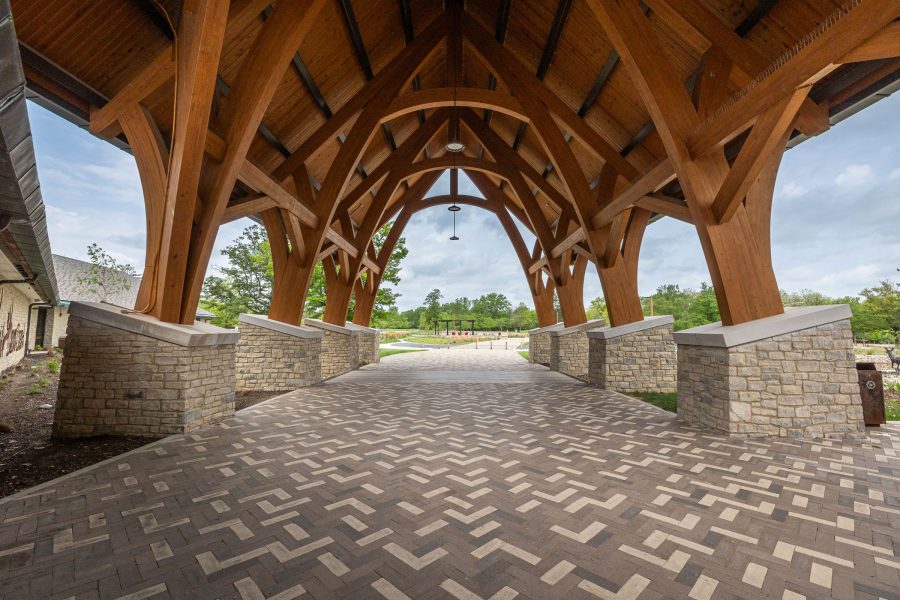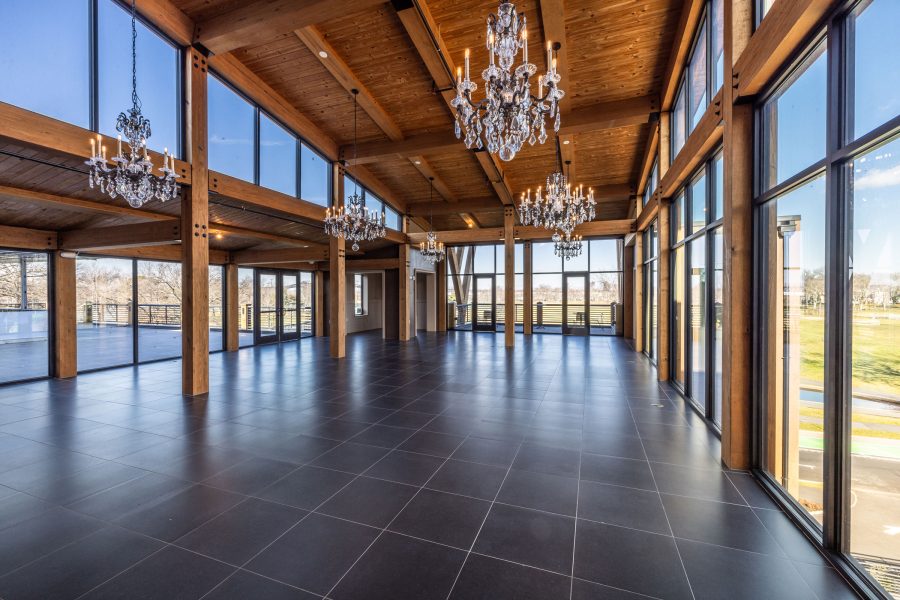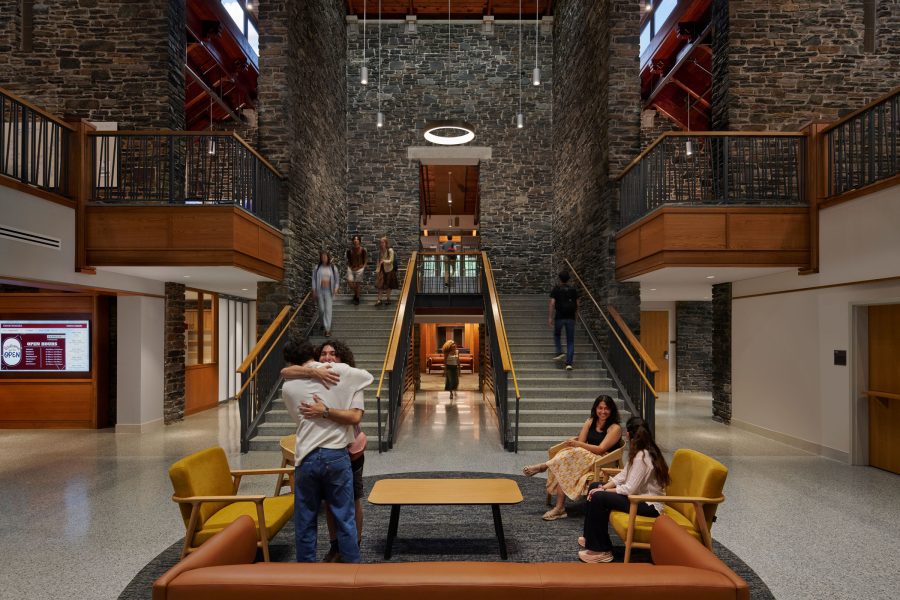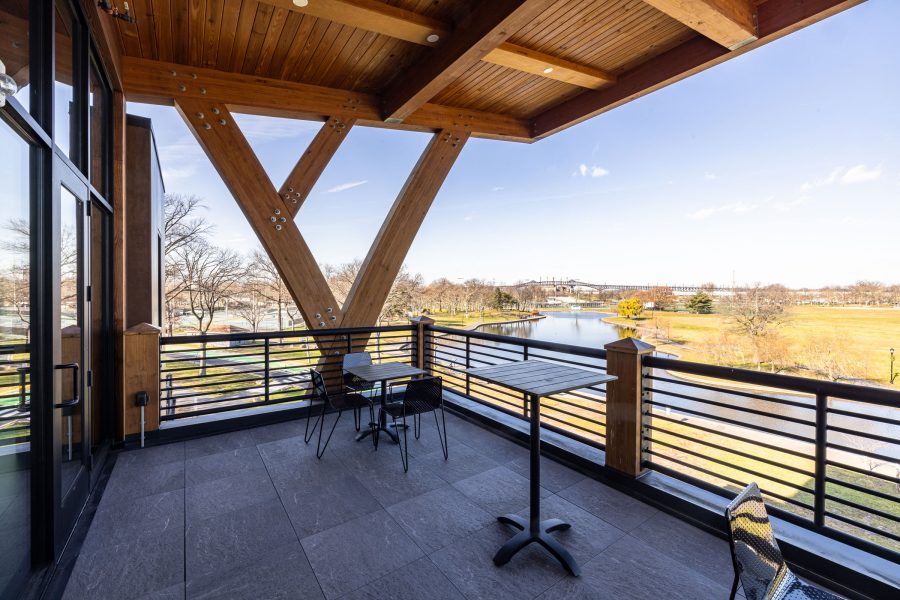Story at a glance:
- Buildings make up a third of greenhouse gas emissions. Sustainability is increasingly a priority for new construction.
- Mass timber produces significantly less emissions than steel and concrete.
- The new dining center and community commons at Swarthmore College is among the first mass timber higher education projects in the US.
Buildings account for 40% of global energy consumption and a third of greenhouse gas emissions, according to the World Economic Forum. To combat climate change, it’s crucial that architects design new buildings with sustainability top of mind.
Mass timber is helping to reduce buildings’ carbon footprint. Use of the engineered wood product has been on the rise in the US over the past decade, as the demand to make buildings more sustainable continues to grow.
Sustainable design was a top priority for a dining center and community commons at Swarthmore College in Swarthmore, Pennsylvania. Its mass timber structure is a key feature of the dining center, which opened in October 2022, as well as Sharples Commons, opened in February 2024, both designed by DLR Group.
Talks with Swarthmore centered on sustainability from the very beginning, according to DLR Group Principal and Higher Education Design Leader Benjamin Strain. Not only had Swarthmore set a goal to become a carbon-neutral campus by 2035, but the college wanted the new building to reflect values of sustainability, inclusion, and well-being for its students.
“This was our first mass timber project in higher education, and it’s one of the few mass timber projects on a higher education campus,” Strain says. “More and more are coming, but it was one of the first ones in the US.”
Less Emissions & More Carbon Sinks

The Deer Creek State Park lodge in Ohio underwent significant renovations, including a new mass timber entrance from Mid-Atlantic Timberframes. Photo by Jana Bannan Photography, courtesy of Mid-Atlantic Timberframes
The benefits of mass timber for sustainability fall into two major buckets: reduced emissions and carbon sequestration. Trees capture and store carbon dioxide during photosynthesis, thereby keeping this greenhouse gas out of the atmosphere and mitigating climate change. “With timber, it’s kind of remarkable that this building material is growing straight out of the ground,” says Mid-Atlantic Timberframes General Manager Mike Banta, who was also involved in the Swarthmore project.
For the dining hall and community commons at Swarthmore, the choice to use mass timber instead of steel saved nearly 300 metric tons of carbon dioxide, according to DLR Group. Additionally, more than 250 metric tons of CO2 were sequestered in mass timber growth, according to a report from the architects.
Recent studies have shown that mass timber produces far less greenhouse gas emissions than other building materials like steel and concrete. Researchers in South Korea examined the environmental impact of reinforced concrete, cross-laminated timber (CLT), and timber-concrete composite (TCC) that had the same structural performance in a 2023 study. (CLT falls under the umbrella of mass timber, which includes especially high-performing timber-based building materials.) Of the three, CLT emitted the least carbon dioxide. Specifically, CLT emitted 75% less and TCC emitted 65% less carbon dioxide than concrete.
Sustainability & Performance

The View at Lincoln Park in Jersey City includes 15,000 square feet of mass timber from Mid-Atlantic Timberframes. Photo by Jana Bannan Photography, courtesy of Mid-Atlantic Timberframes
While it’s been talked about and used for years, not everyone understands the benefits of incorporating mass timber into new buildings. Both Strain and Banta say education is critical.
DLR Group has conducted presentations at universities, facility management offices, and even insurance underwriters. Strain says that when people hear about timber as a building material, some think of simple residential construction or picture a bunch of logs stacked together. He says mass timber is a very safe building material; as wood burns, a layer of protective char forms on the surface while the interior maintains its strength. “Once a steel structure hits [its melting point], it will fail instantly,” Strain says. “Mass timber has the built-in safety of a char layer.”
Banta says mass timber’s strength comes in part from how the pieces of wood are glued together, plus the ability to pick the strongest wood pieces.
When mass timber CLT panels arrive at a construction site, Strain likens the process to building an Erector Set or playing with Legos: “It really just clips together.”
Biophilic Benefits

Sustainable design was a top priority for a dining center and community commons at Swarthmore College in Swarthmore, Pennsylvania. Photo by Brad Nicol, courtesy of DLR Group
Biophilia describes the innate human inclination to connect with nature, and architects are increasingly applying this concept to their work. Biophilic design is at the core of Swarthmore’s new dining hall and community commons—from the mass timber structure to the emphasis on natural light. This design strategy also meant Strain and his team didn’t have to add lots of interior finishes because the wood was already naturally warm and inviting.
During tours of the dining hall and community commons, Strain inevitably sees someone leaning on or even hugging a column. “The more we’ve grown as society into the built world, the more we recognize the need to get back to natural beauty, to nature,” he says.
“Humans will always go to the beach. They will always go to the mountains. They will always find a meadow. Bringing that into our designs is imperative as we continue to build.”

The View at Lincoln Park in Jersey City includes 15,000 square feet of mass timber from Mid-Atlantic Timberframes. The project was designed by Jeffrey A. Fleisher Architect. Photo by Jana Bannan Photography, courtesy of Mid-Atlantic Timberframes

